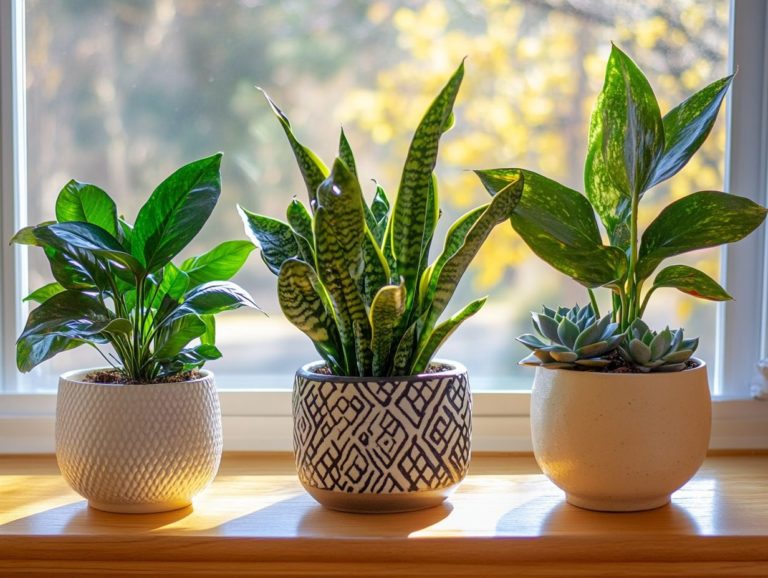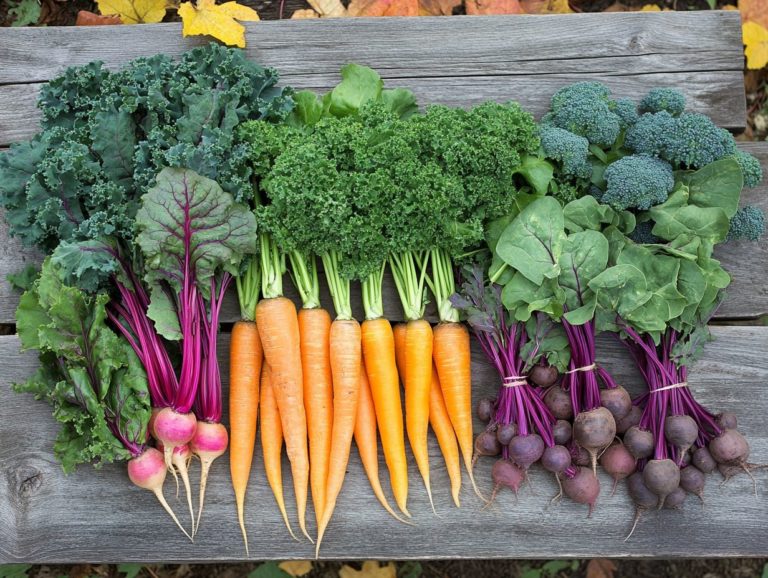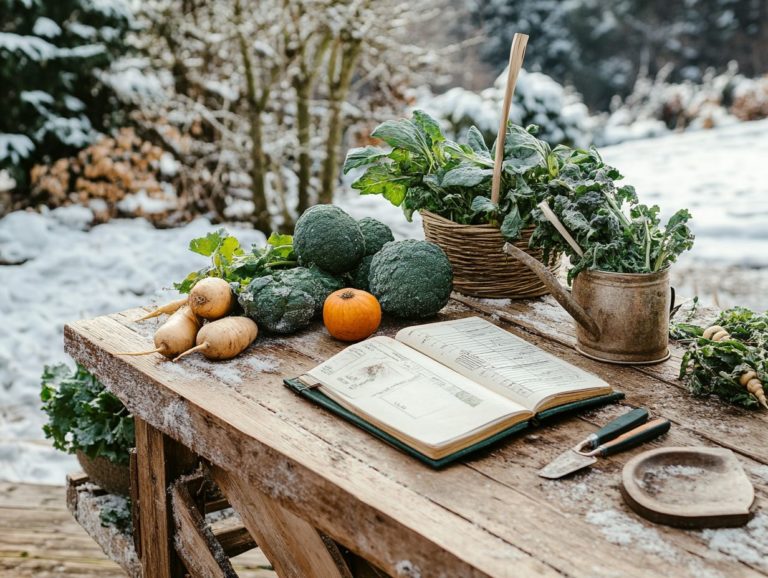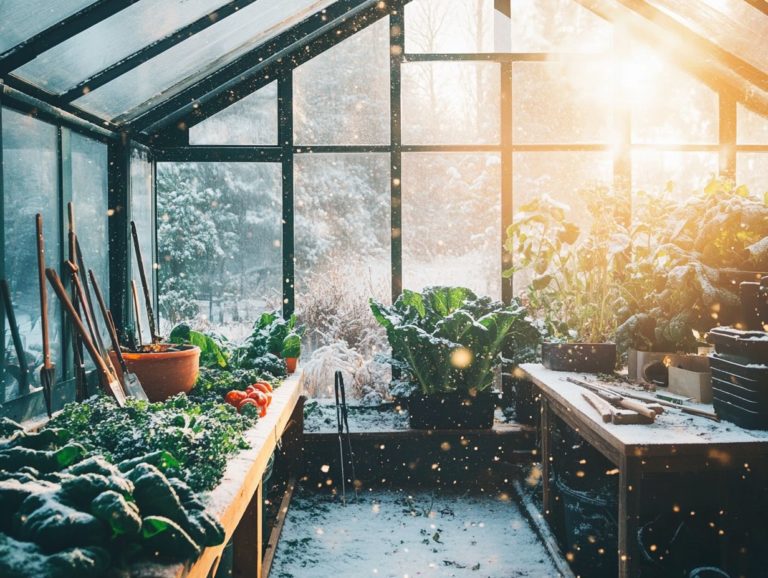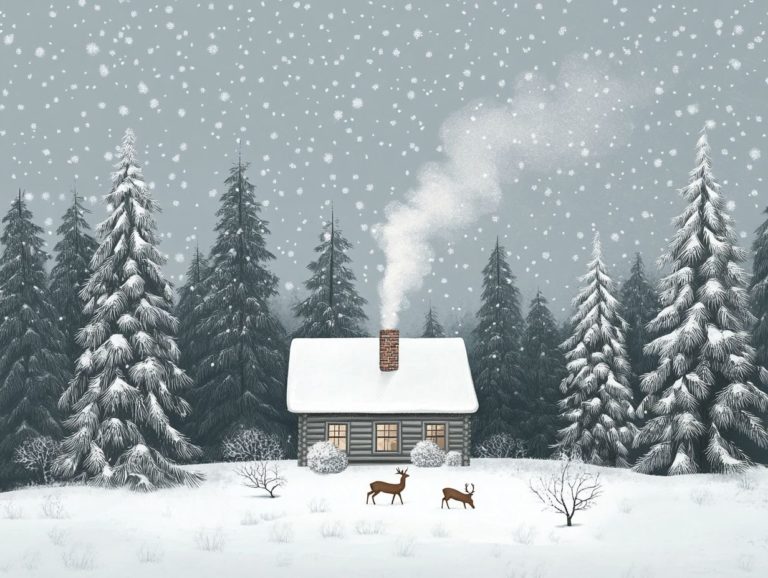Creating a Winter Garden Design
A winter garden can transform into a magical escape, brimming with vibrant colors and textures, even during the coldest months.
This article delves into the myriad benefits of a winter garden, highlighting its positive environmental and health impacts. It also covers practical design considerations that can elevate your space.
You ll discover how to select the right plants and layout, ensuring your garden remains visually captivating throughout the winter.
With expert tips on maintaining your garden during this season, you ll set the stage for thriving beauty year-round.
Join us on this exciting journey to unlock the secrets of creating your very own winter wonderland!
Contents
- Key Takeaways:
- Benefits of a Winter Garden
- Key Considerations for Winter Gardens
- Designing for Winter Interest
- Maintaining a Winter Garden with Winter Plants
- Winter Care and Protection for Plants: Design Strategies
- Winter Garden Tasks and Maintenance Schedule: Gardening Tips
- Frequently Asked Questions about Winter Garden Design
- What is a winter garden design with colorful winter blooms?
- What are some key elements to consider when creating a wildlife garden or winter garden design?
- What are some plants that are suitable for a winter garden design, including winter flowers?
- Do I need a lot of space to create a winter garden design with vibrant stems?
- Can I still enjoy my winter garden design, including aromatic winter blooms, even if I don’t live in a cold climate?
- How can I maintain my winter garden design during the colder months with gardening tips?
Key Takeaways:

- Designing a winter garden can bring environmental and health benefits such as improving air quality and reducing stress.
- When creating a winter garden, consider the climate, plant selection, layout, and structure to ensure a thriving and visually appealing garden.
- Incorporating winter plants with color and texture, as well as hardscaping elements, can add interest and beauty to a winter garden design.
Understanding Winter Gardens
A winter garden is your opportunity to create a meticulously curated outdoor space that showcases winter plants and engages children. Consider planning a winter garden for kids to add visual intrigue during the colder months.
This type of garden serves as a vibrant canvas, featuring colorful stems, evergreen shrubs, and aromatic plants that maintain their aesthetic appeal long after most flowering plants have bid farewell.
Among the key highlights of a winter garden are the plants that have interesting shapes, beautifully complementing the unique allure of winter blooms like Daphne bholua and Chimonanthus praecox. This ensures that you enjoy the garden year-round.
Beyond the standout blooms, a well-planned winter garden invites you to explore a variety of textures and layers that elevate its overall charm. Selecting plants with distinctive bark or intriguing leaf shapes think the smooth branches of Betula utilis or the thick-leaved forms of Sarcococca can significantly enhance the garden’s visual depth.
Design strategies are essential. Incorporating pathways made of natural stones or rich mulch not only adds warmth but also beckons you to wander through the space.
Even amidst the frost-laden landscape of winter, your garden can echo the brilliance found in renowned places like Kew Gardens. Thoughtful design and seasonal interest plants such as winter jasmine or hellebores create a lively atmosphere that defies the chill.
Benefits of a Winter Garden
Creating a winter garden brings a wealth of benefits, enriching your environment and enhancing your well-being. This garden not only transforms your living space with striking architectural elements and vibrant winter plants, but also acts as a sanctuary for local wildlife. Explore creative ways to decorate your winter garden for even more inspiration.
It provides essential habitats during the colder months and serves as a beautiful wildlife garden.
The delightful seasonal scents and thoughtfully arranged visuals can boost your mental health and emotional well-being, making it a truly rewarding endeavor.
Environmental and Health Benefits
Winter gardens not only elevate the aesthetic appeal of your landscape but also promote environmental sustainability and enhance personal well-being. By incorporating native winter plants and evergreen shrubs, you create essential habitats and shelters for local wildlife.
Your garden remains a source of year-round interest and beauty, enhancing the overall garden aesthetics.
These gardens are vital in supporting local ecosystems by attracting beneficial pollinators and birds, effectively fostering biodiversity. The presence of winter blooms serves as food during the lean months, ensuring that wildlife has access to sustenance even amidst the chill of colder seasons.
Beyond their ecological contributions, winter gardens offer significant health benefits. Engaging in gardening activities can be a powerful antidote to stress, encouraging physical exercise and boosting your overall well-being as part of your winter maintenance routine.
The serene scenery of lush greens and vibrant hues can lift your spirits, providing a therapeutic escape from the often dreary winter weather.
Are you ready to transform your space? Start planning your winter garden today!
Key Considerations for Winter Gardens
When you design a winter garden, there are several important things to consider to craft an outdoor space that not only enchants but also flourishes in the colder months. Having a solid winter garden plan can make all the difference.
Start with a careful selection of plants suited to your specific climate. To maximize your garden’s potential, learn how to plan your cold-climate garden layout to ensure you have year-round interest with resilient evergreen structures and optimal plant combinations. Incorporating a variety of ornamental grasses and winter blooms will add texture and color to your garden’s palette.
Planning for winter maintenance is crucial. Think about frost protection strategies and effective pruning techniques to preserve the health and beauty of your garden throughout the season and enhance your garden planning.
Climate and Plant Selection
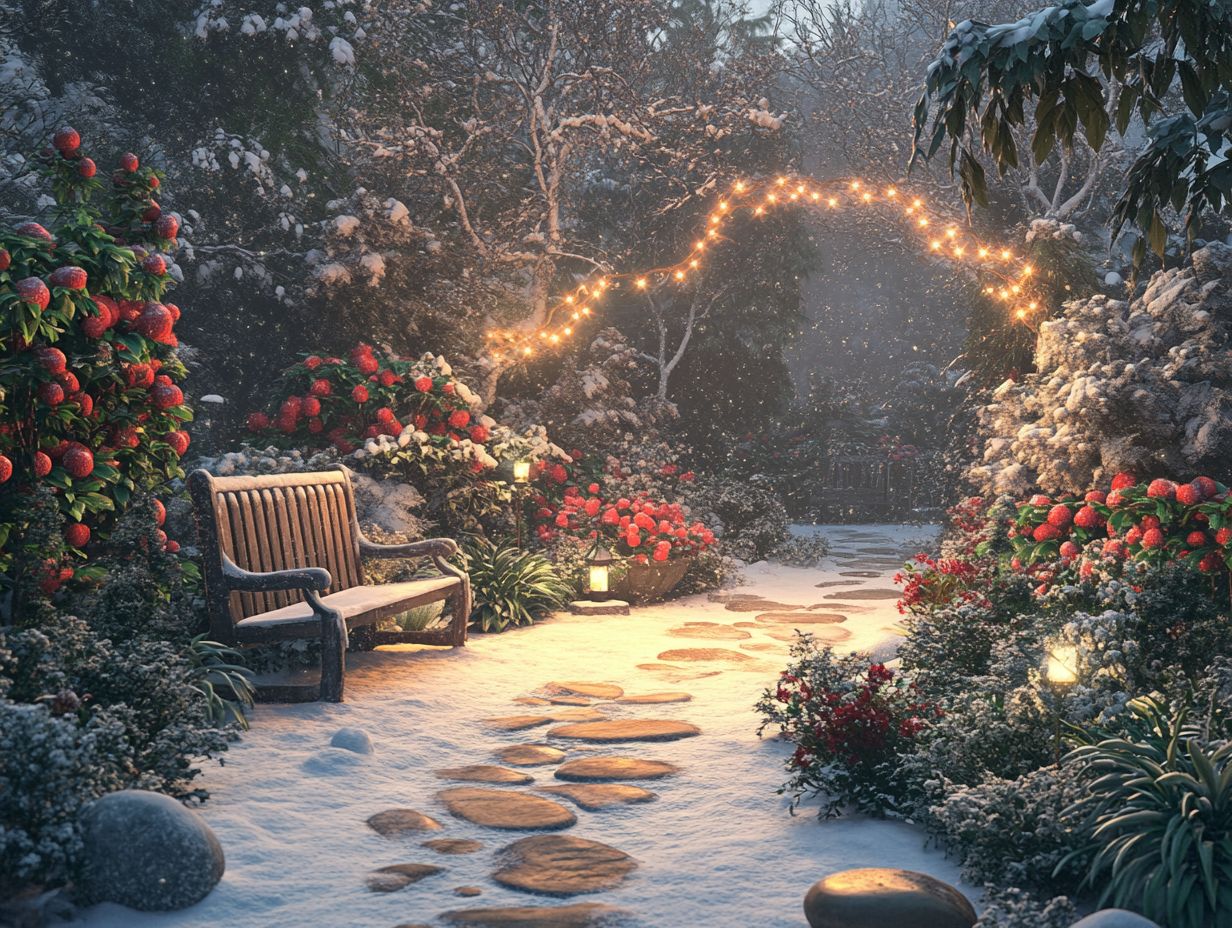
Choosing the right plants for your winter garden requires understanding your local climate. Select plants that can withstand colder temperatures and enhance the visual appeal of your space. This includes a delightful array of winter plants, such as evergreen shrubs, aromatic winter blooms, and even winter vegetables, each playing a vital role in both aesthetics and functionality.
In regions with milder winters, consider trees like the southern magnolia. It offers a stunning contrast with its glossy leaves and large, fragrant flowers. For those in colder areas, hardy perennials such as hellebores bloom in late winter, showcasing an enchanting spectrum of colors from soft pastels to deep purples.
Don t overlook plants like winterberry holly, which introduces vibrant red berries and attracts birds during chilly months. By selecting plants that are well-suited to your specific climate, you can cultivate a lively winter garden that transforms your outdoor space into a welcoming oasis even in the coldest seasons!
Layout and Structure
The layout and structure of your winter garden are vital to its overall appeal and functionality. This ensures it remains captivating even when other gardens seem to be on pause. By embracing design strategies, such as how to create a winter garden design, you can introduce architectural plants and vibrant stems that elevate the visual landscape during the colder months.
Incorporating diverse plant placements is essential for cultivating a sense of balance and harmony throughout the space. Layer plants with different heights and textures; placing taller evergreens at the back creates a stunning backdrop for delicate, colorful perennials at the front.
Integrating non-plant features like paths, benches, or trellises will guide the eye and inspire deeper exploration. Don t underestimate the power of strategic lighting it can highlight key plants and features, adding warmth to the winter atmosphere.
With your design, you ll create a cozy winter sanctuary that invites enjoyment!
Designing for Winter Interest
Designing for winter interest means crafting a garden that captivates and engages your senses, even in winter’s chill. Consider incorporating a diverse array of plants by selecting plants for a winter garden that provide colorful arrangements.
Think about fragrant flowers and vibrant stems, paired with structural elements that enhance the garden’s aesthetics and offer visual intrigue through winter blooms.
Start designing your winter garden today!
Choosing Plants for Winter Color and Texture
Selecting plants for winter color and texture is essential for crafting a stunning winter garden that captivates during the colder months. Focus on colorful winter arrangements by choosing a diverse array of winter flowers, evergreen shrubs, and textured plants. These selections will offer contrasting colors and shapes, ensuring your garden remains vibrant throughout the season. Consider adding winter hanging baskets for extra beauty.
Incorporate winter-blooming plants like Hellebores and Cyclamen. Their striking blooms provide a delightful splash of color that enhances your winter garden ideas. Evergreens such as Boxwood and Holly introduce texture and create a timeless backdrop for your landscape. The bright red berries of Winterberry and the golden hues of various grasses elegantly complement your selections.
By pairing these elements with lively evergreens, you can create a rich tapestry of colors and textures, ensuring your winter garden stands out against the frosty landscape.
Incorporating Hardscaping Elements
Adding non-plant elements to your winter garden, like pathways, benches, and decorative stones, is crucial for establishing structural interest and enhancing the overall aesthetics. These features create focal points that enhance the lush greenery and vibrant colors of your winter plants while ensuring functionality.
Integrating raised garden beds not only defines your space but also improves drainage during winter rains. This prevents waterlogged soil that could jeopardize delicate roots and enhances your kitchen garden capabilities. A strategically placed fire pit or outdoor heater adds warmth, making your garden inviting even in colder months.
Natural stone walls serve a dual purpose as a windbreak and a stunning backdrop, allowing your winter flora to pop against the rugged texture. Each hardscaping feature contributes to the visual beauty and the health and usability of your garden throughout the winter season, enhancing your overall garden aesthetics.
Maintaining a Winter Garden with Winter Plants
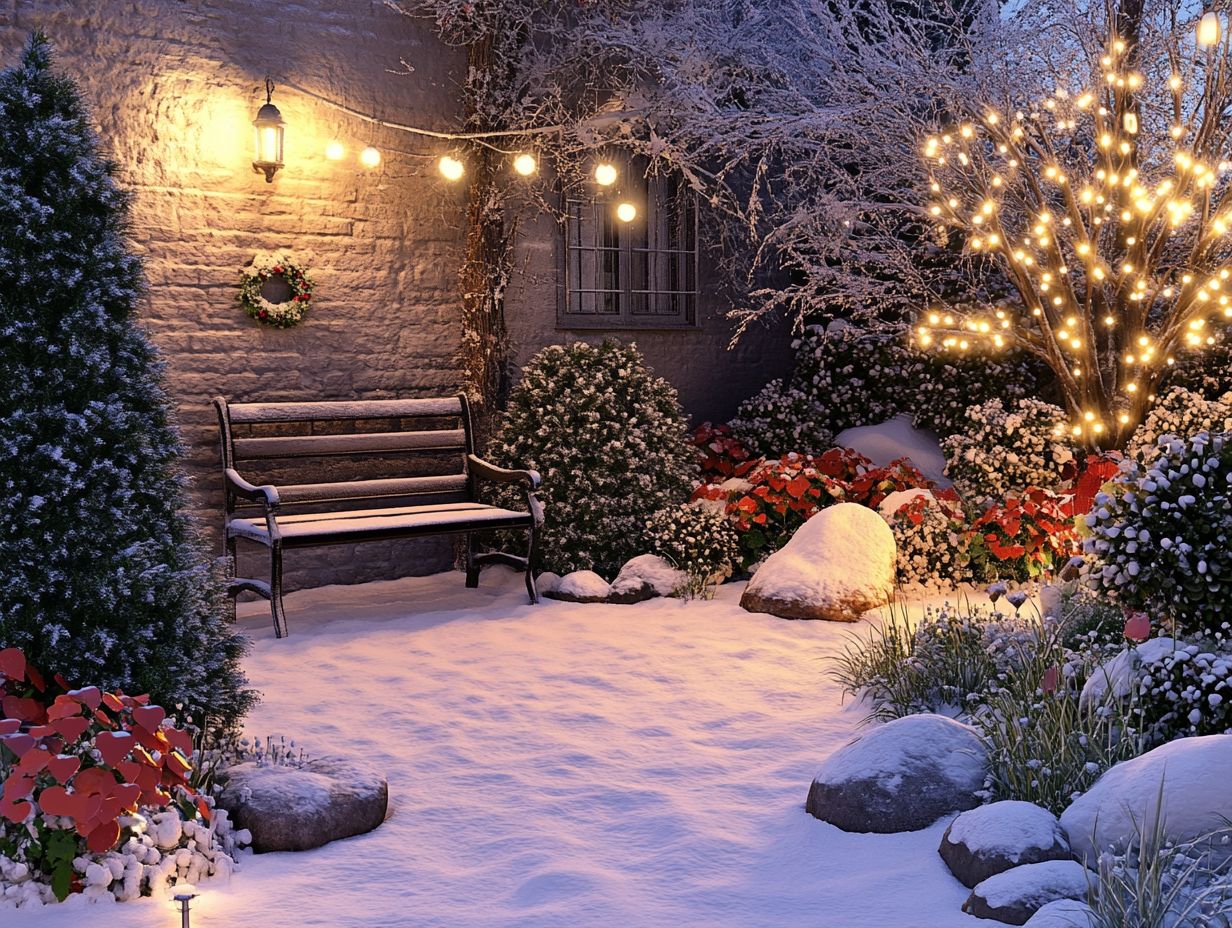
Keeping your winter garden beautiful is essential, and it’s easier than you think! This requires specific care tasks, such as ensuring proper winter maintenance and diligent monitoring.
To ensure your garden thrives and incorporates winter interest, focus on key aspects of winter maintenance:
- Use effective frost protection to keep your winter flowers safe.
- Utilize proper pruning techniques to enhance the garden structure.
- Establish a structured schedule for seasonal tasks.
With these practices in place, you can keep your garden healthy and looking its absolute best, creating a vibrant space for wildlife shelter.
Winter Care and Protection for Plants: Design Strategies
Proper winter care and protection for your plants are vital for maintaining their health and longevity during colder months. Techniques like using mulch for insulation, implementing frost protection, and selecting the right plant combinations can help ensure that your winter plants, including evergreen shrubs and ornamental grasses, stay in peak condition.
Consider where you place your plants; putting them in sheltered areas acts as a natural barrier against harsh winds. Regularly check for signs of distress like wilted leaves or discoloration to intervene promptly. Using row covers or cloches can also trap warmth during frigid nights.
Ensuring adequate hydration before the deep freeze sets in significantly boosts their resilience. By taking a holistic approach to care and incorporating winter garden ideas, your winter garden can thrive, even when the weather outside is far from inviting.
Start implementing these tips today to enjoy a vibrant winter garden!
Winter Garden Tasks and Maintenance Schedule: Gardening Tips
Creating a winter garden maintenance schedule is key to ensuring that essential tasks are tackled on time. This promotes the overall health and beauty of your wildlife garden and outdoor sanctuary.
By breaking these tasks down into manageable segments, you can systematically address each requirement. This ensures that no important detail slips through the cracks. A well-organized plan might include setting a timeline for checking soil moisture levels and scheduling timely fertilization to give your wintering plants a robust foundation.
Make sure you set aside time for seasonal clean-ups. Clearing away debris can help prevent pests and diseases. Focusing on these routines strengthens your garden’s resilience and enhances your overall gardening experience, ultimately benefiting the environment and promoting sustainability.
Frequently Asked Questions about Winter Garden Design
What is a winter garden design with colorful winter blooms?
A winter garden design is a type of garden specifically planned to thrive during the winter months. It typically includes plants like winter blooms and features that can withstand colder temperatures while providing visual interest and beauty. To enhance your space, consider exploring how to create a winter garden atmosphere during the winter season.
What are some key elements to consider when creating a wildlife garden or winter garden design?
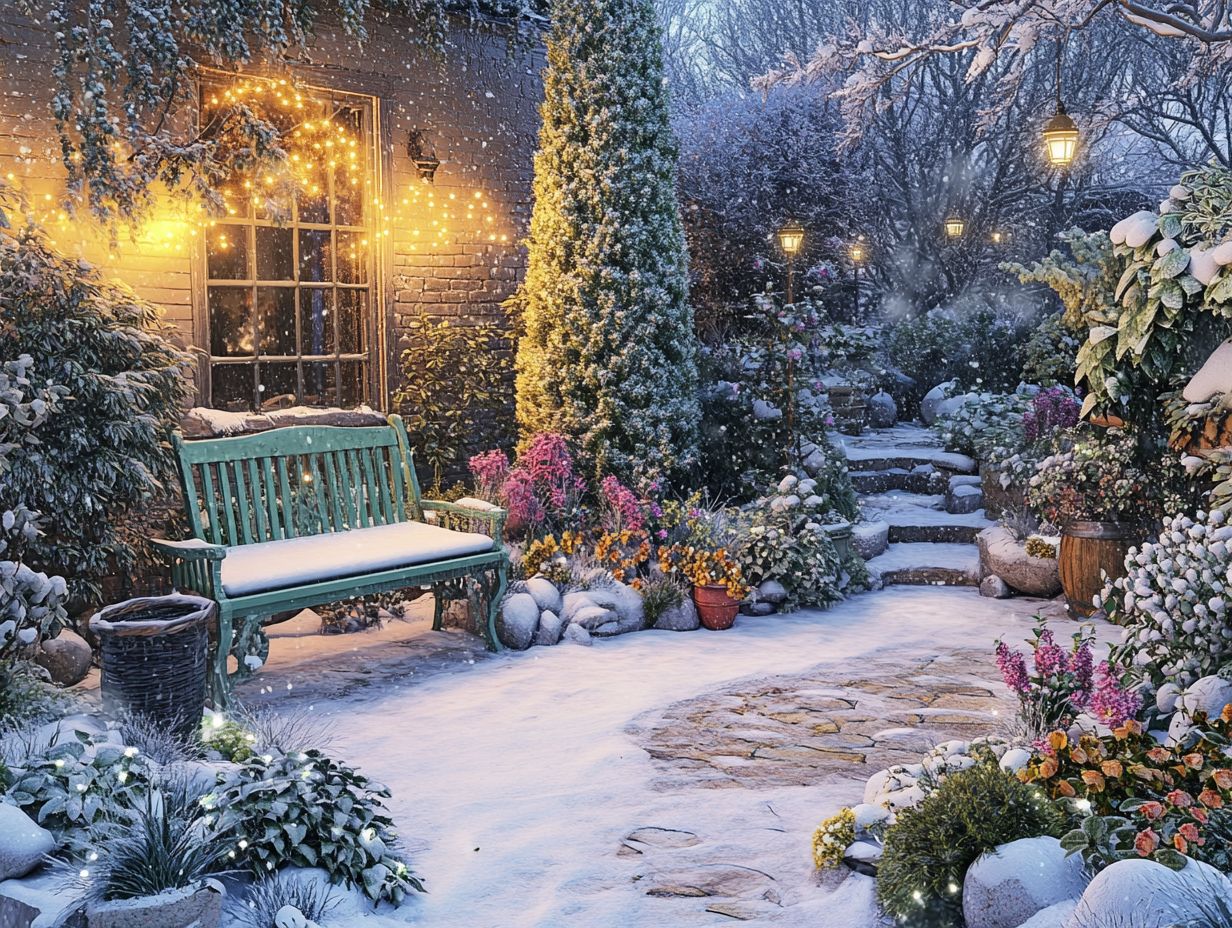
When creating a winter garden or wildlife garden, it is important to consider factors such as plant hardiness. Choose evergreen plants, which stay green all year, and add colorful features while ensuring proper drainage for cold weather conditions.
What are some plants that are suitable for a winter garden design, including winter flowers?
Some plants ideal for a winter garden design include winter flowers, winterberry, snowdrops, and winter jasmine. These plants can withstand cold temperatures and still provide beauty and interest.
Do I need a lot of space to create a winter garden design with vibrant stems?
No, you do not need a lot of space to create a winter garden design. Even a small balcony or patio can be transformed into a winter garden by incorporating potted plants, evergreen shrubs, and features like bird feeders or winter-themed decorations that add colorful arrangements.
Can I still enjoy my winter garden design, including aromatic winter blooms, even if I don’t live in a cold climate?
Yes, you can enjoy a winter garden design, including aromatic winter blooms, even in a mild climate. Many plants, like camellias, witch hazel, and winter-blooming heather thrive in mild winter temperatures. You can also add winter-themed decorations to create a cozy and inviting atmosphere.
How can I maintain my winter garden design during the colder months with gardening tips?
To maintain a winter garden design, regularly remove fallen leaves and prune dead or damaged branches using pruning techniques. Additionally, you can learn how to create a winter gardening toolkit to protect sensitive plants from harsh weather, and add winter mulch to insulate the soil and provide nutrients during the dormant season. This enhances the garden beauty.
Start your winter garden today and watch it thrive!


